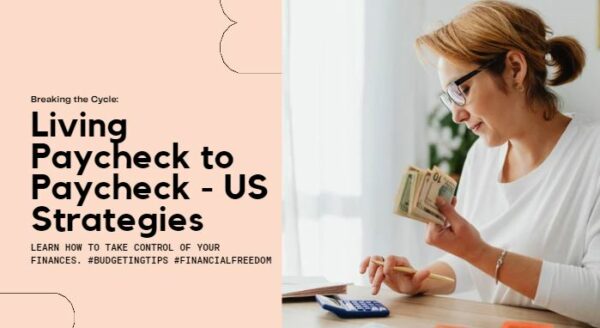Living paycheck to paycheck is a situation where a person’s income is just enough to cover their basic expenses, leaving little to no savings or cushion for emergencies.
It’s a stressful cycle that many people find themselves trapped in, but it’s not impossible to break free from it.
In the United States, there are strategies and resources available to help individuals and families escape this cycle and achieve financial stability.

Understanding the Cycle
Living paycheck to paycheck often begins with low wages or unstable employment. When your income barely covers rent, utilities, groceries, and other essential expenses, saving money becomes a luxury.
Any unexpected expenses, like car repairs or medical bills, can quickly derail your budget and push you further into debt.
Breaking the Cycle
Breaking free from living paycheck to paycheck requires a combination of mindset shifts, budgeting techniques, and access to resources. Here are some strategies that can help:
1. Budgeting
Creating a budget is essential for understanding where your money is going and identifying areas where you can cut back.
Start by listing all your sources of income and expenses. Allocate a portion of your income to savings, even if it’s a small amount.
There are many free budgeting tools and apps available online to help you track your spending and stay on target.
2. Emergency Fund
Building an emergency fund is crucial for weathering unexpected financial storms without resorting to high-interest loans or credit cards.
Aim to save at least three to six months’ worth of living expenses in a separate savings account. Start small if you have to, but make saving a priority.
3. Increasing Income
Consider ways to increase your income, whether through asking for a raise, taking on a second job, or exploring opportunities for career advancement.
Look for ways to develop new skills or certifications that can make you more valuable in the job market.
4. Debt Management
If you’re carrying high-interest debt, such as credit card debt or payday loans, focus on paying it off as quickly as possible.
Consider consolidating your debt or negotiating with creditors to lower your interest rates. Avoid taking on new debt whenever possible.
5. Government Assistance Programs
In the US, there are various government assistance programs available to help low-income individuals and families meet their basic needs.
Programs like SNAP (Supplemental Nutrition Assistance Program), Medicaid, and housing assistance can provide temporary relief while you work on improving your financial situation.
You can check your eligibility and apply for these programs through the official website of Benefits.gov.
6. Financial Education
Educating yourself about personal finance and investing can empower you to make better financial decisions and build wealth over time.
Take advantage of free resources such as online courses, workshops, and community classes offered by nonprofits and government agencies.
7. Seek Support
Don’t be afraid to seek support from friends, family, or professionals if you’re struggling with your finances.
You’re not alone, and people and organizations are willing to help you navigate through tough times.
Taking Control: Building a Budget
The first step to breaking free is gaining control of your finances. Here’s where a budget comes in – it’s like a roadmap for your money.
- Track your income: List all your income sources, including your paycheck, side hustles, or any government benefits.
- Track your expenses: For a month, write down everything you spend money on, from rent and groceries to morning coffee and weekend movie tickets. Categorize your expenses (housing, food, transportation, etc.) to see where your money goes.
- Free budgeting tools: There are many free online budgeting tools and apps like Mint (https://mint.intuit.com/) or You Need a Budget (YNAB) (https://www.ynab.com/) that can simplify this process.
Cutting Back: Prioritizing Needs vs. Wants
Living frugally doesn’t mean depriving yourself entirely. It’s about prioritizing needs over wants. Here are some ideas to trim your expenses:
- Housing: Look for roommates, negotiate rent if possible, or consider a cheaper location if you’re flexible.
- Food: Plan your meals, cook more at home, and take advantage of grocery store deals and coupons. Consider budgeting for occasional takeout or dining out, but limit it.
- Transportation: Can you walk, bike, or use public transportation more often? Can you carpool with colleagues?
- Subscriptions: Review your subscriptions for streaming services, gym memberships, or magazines. Cancel those you rarely use.
- Entertainment: Find free or low-cost alternatives for entertainment. Visit libraries, parks, or museums with free admission days.
Building a Safety Net: The Emergency Fund
Unexpected expenses happen. A car breaks down, the washing machine overflows – life throws curveballs.
An emergency fund helps you weather these storms without going into debt. Start small – aim to save $500 or $1,000. Every little bit counts.
There are several ways to build your emergency fund:
- Automate your savings: Set up a recurring transfer from your checking account to your savings account. Even a small amount each payday adds up over time.
- The 52-Week Challenge: There are many variations of this challenge. One way is to save $1 in week one, $2 in week two, and so on, increasing your savings by $1 each week. By year’s end, you’ll have saved over $1,300!
Taming the Debt Dragon
Debt, especially high-interest credit card debt, can make it nearly impossible to save. Here are ways to tackle debt:
- The snowball method: List your debts from smallest to largest (regardless of interest rate). Pay off the smallest debt first, then use the money freed up to pay off the next smallest, and so on. The feeling of accomplishment from seeing debts disappear can be motivating.
- The avalanche method: Focus on paying off the debt with the highest interest rate first. This saves you money in the long run.
Conclusion
Living paycheck to paycheck can feel like an endless cycle of stress and financial insecurity, but it’s possible to break free with the right strategies and resources.
By budgeting wisely, building an emergency fund, increasing your income, managing debt, accessing government assistance programs, investing in financial education, and seeking support, you can take control of your finances and work towards a more stable and prosperous future.
